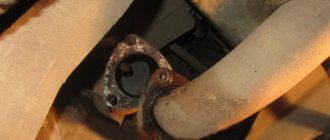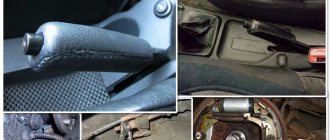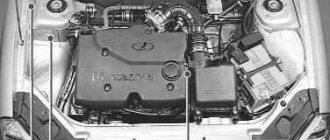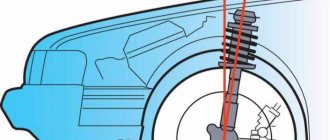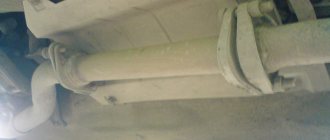What you need to know
You also need to know what the toxicity standard of your car is.
This is quite easy to determine. On EURO 2, sensors are not installed after the catalyzer. EURO 3 has an oxygen sensor installed after the catalytic converter. It provides the controller with information about its operating efficiency. But why spend money if you can just make a hole in the cata, empty it and install just the housing? The solution is cheaper, but much less correct. An empty housing will make your car even louder, but this is not a hindrance. The neutralizer itself is a set of square “honeycombs” of small cross-section (0.5×0.5 mm); they, like channels, run parallel to each other in the direction of exhaust gas movement. Their total cross-sectional area is approximately equal to the cross-sectional area of the pipe, but the cross-sectional area of the neutralizer and the housing is much larger than the cross-sectional area of the pipe. And as a result, when installing an empty housing, we will get an exhaust section with a large cross-section, where the normal movement of exhaust gases will be disrupted. That is why it is recommended to install the insert.
In recent years, kats have begun to be produced on a metal base, so it is no longer possible to simply empty its body. Now you need to cut it and cut out the metal “honeycombs”, and then weld the body. Front-wheel drive VAZs with 1.4 and 1.6 liter engines have a catalyst, which is made as a single part with the exhaust manifold. Therefore, when the kata is removed, the volume of the motor increases greatly. In these car models, the best solution would be to install a manifold from a 1.5-liter (VAZ 2110, 2111, 2112) engine or a sports spider (exhaust manifold). In the case of installing a spider, it is necessary to consult with specialists, since there are known cases of power loss and other negative aspects when installing low-quality collectors.
With EURO 3 engines the process becomes more interesting. There is a need to deceive the electronic systems of the engine (lambda probe installed after the catalytic converter). This can be done in two ways:
- Installing the emulator.
- Reflashing the control side to EURO 2 standards (more correct) As a result, if the lambda probe comes after the cat, then it is better to reflash the control unit.
Now let's take a closer look at the models
VAZ 2110, 2111, 2112 With a 1.5-liter power unit, the catalyst is a separate unit under the bottom of the car. Here you need to delete it and make an insert. On VAZ 2110, 2111, 2112 with 1.6 liter engines a catalytic collector is installed. In this case, it must be removed and a new cat collector or sports spider installed.
https://youtube.com/watch?v=8yWlL3wvCzE
How to repair the exhaust system
Repair of exhaust system parts is done only if holes from mechanical impact have been discovered. If the pipe breaks and the tank burns out, it is necessary to completely replace the parts. Their warranty period has expired. It must be said that metal expansion joints are changed in any case, regardless of the condition of the exhaust system.
Due to the fact that the catalyst is very expensive, amateurs weld a stronger instead. The catalyst is cut off, leaving only the connecting flanges together with the flaring. A stronger is welded into the vacant space. This part costs much less than the catalyst. However, the stronger is not able to burn the remaining gasoline. For this reason, it can only be mounted on a car equipped with a lambda probe. After installing the stronger, gasoline consumption increases by approximately 10%.
Cars equipped with engines with 16 valves often have two metal expansion joints attached to the “pants”. The size of such corrugation does not exceed 50 mm. The cost of such a receiving pipe is incredibly high. The industry does not produce metal expansion joints of this size. The only solution is to insert a corrugation measuring 100 mm and then adjust the length. Welding is done end-to-end with the “pants” and the gasket flange.
Catalyst replacement
Replacing the catalyst for a VAZ 2110, a video of the process can be viewed on our website. For work we will need the following tools:
- wrenches - set;
- heads - set;
- screwdrivers - set.
Removal
Replacing the VAZ 21101 catalyst is carried out in the same way as on other models in this series. It is worth noting that we carry out the work after the exhaust system has completely cooled down. So, let's start:
- we lift the car onto a viewing hole or overpass;
- We disconnect the main and additional gas exhaust systems;
- to do this, you need to disconnect the exhaust pipe, and then the additional muffler of the exhaust system;
- Unscrew the fastening nut of the coupling clamp, while holding the bolt from turning with a screwdriver;
- move the clamp to the side;
- take a flat-blade screwdriver and bend the hooks of the suspension straps that secure the main muffler to the bottom of the car;
- disconnect it from the brackets;
- unscrew the bolt securing the catalyst to the pillow using a wrench;
- we remove it from the mounting hole (in some cases the nut may be so tight that it will cause difficulty in removal and in this case the connection must be treated with a special lubricant);
- remove the main muffler;
- before replacing the main muffler suspension cushion, you must first clean the connection from dirt and lubricate it with an easily penetrating compound;
- take the key to 7;
- we find the nut securing the pillow to the bracket and unscrew it;
- remove the airbag from the car;
- We treat the joints of the catalyst with a graphite-containing compound (do not forget about the threaded part of the bolts).
Exhaust system tuning
At this stage, the dismantling of the catalyst can be called complete. All that remains is to replace it with a new factory or homemade one. As a rule, there is no need to buy a new catalyst, since a self-made flame arrester is, in fact, the best muffler for exhaust gases. The tuning exhaust system for VAZ cars is also very popular among Russians today. It consists of an exhaust manifold or spider, which has two patterns: 4/1 and 4/2/1. In addition, the homemade system also consists of a direct-flow resonator with a flow area of 51, less often 60 mm, and a main muffler with a cross-section of 51/60 mm and having a direct-flow design. Replacing the catalyst on a VAZ 21101 is carried out precisely according to this system.
As for the spider system, the photo of which is visible above, this design is most widespread today. The 4/2/1 scheme is especially widely popular, which gives an increase in power that greatly expands the range of operating speeds. Well, the rest of the details of the tuning system. These include a tuned direct-flow resonator, which, in fact, does not provide any power to the engine. But still, it is often installed in the process of replacing a standard catalyst. And finally, the main muffler, made by yourself, which also does not provide any additional power to the car engine, but has a very attractive appearance. And many car owners begin modifying or replacing the exhaust system with it, as required by the instructions.
Manufacturing and installation of a flame arrester
The main task of the flame arrester is clear. This part must be able to promptly extinguish the flame that forms from the exhaust system. Often this is what is installed instead of a conventional catalyst. In order to make a flame arrester, you need to take a piece of pipe. It should have an outer diameter of 76mm and a wall thickness of 3mm.
We find the catalyst housing.
There is a protrusion on it that will serve as a support for our pipe. For fixation, we make metal rings with an outer diameter of 10.7 mm and an inner diameter of 76 mm.
- We make cuts on one side of the pipe;
- we rest the other part of the pipe against the catalyst body;
- drill holes in the pipe;
- insert metal brushes into it for washing dishes;
- We brew it on the body.
The instructions described above will not only help novice car owners learn a lot, but also save a lot of money. After all, the price for such types of services today is very high and not every master will undertake to change the exhaust system of your car, doing the tuning with his own hands.
Independent production and installation of a flame arrester
Most auto-tuning workshops have found an alternative version of the catalyst. A flame arrester is installed instead. It can be easily made even in the garage. Auto mechanic services are not required. The main function of a flame arrester is to extinguish the fire escaping from the collector.
This flame has a very high temperature, so one of the muffler parts may burn out. If you weld an ordinary straight pipe instead of a catalyst, removing the internal parts located in the body of the catalyst, the exhaust system will quickly become unusable.
It will simply burst and burn out, and you will have to completely replace it. A flame arrester comes to the rescue, which has properties similar to those of the catalyst. It does not interfere with the movement of flows and is much cheaper than a catalyst. You can buy such a flame arrester at auto parts stores. But sometimes they are not on sale. Therefore, the part is often made by hand. To work you must have:
- metal pipes;
- steel brushes;
- welding machine.
Pipes must have specific diameters. One should match the size of the exhaust system, the other should be slightly larger. Six-millimeter holes are made in the first pipe with a diameter corresponding to the diameter of the leading system pipe. They are drilled along the entire circumference and length. It is then inserted into a pipe with a larger diameter and, after centering, welded at one end.
Using brushes, the pipes are stretched and then pushed inside. They are compacted with a steel rod. This operation is done until the entire free space of a larger diameter pipe is filled with brushes. When the operation using brushes is completed, the free end of the pipe is welded, the edges are first bent.
The result was a ready-made flame arrester, made independently. This part can be mounted on a car instead of a catalyst. A vehicle equipped with a flame arrester will run perfectly and quietly.
Reasons for catalytic converter failure
As mentioned above, the service life of the catalyst is estimated at 140 thousand kilometers. In addition, the duration of the catalyst operation depends on the proper operation of the fuel drive and ignition systems. If there are misfires in the ignition, this leads to overheating of the clay cells. As a result of a breakdown of the catalytic converter, the main systems of the car deteriorate. This especially applies to exhaust systems and normal engine operation. The car begins to feel a little dull, and the owner associates this condition with other parts. Therefore, timely repair of the catalyst is so important. In addition, driving a car with a damaged catalyst is not recommended. Replacing the VAZ 2110 8 valve catalyst is the best solution in this case. After all, operating a car in such cases can cause damage not only to important parts, but also lead to a fire of the entire system. Modern cars have a special sensor, which is programmed to turn on the emergency mode of operation of the car in such cases. The cause of failure of the catalyst can be clogging. It is usually caused by the use of low-quality fuel containing certain impurities that accumulate on the walls of the internal valves.
Part Description
Experts from their practical experience have concluded that replacing the catalyst on a VAZ 2110 should be carried out after every 100,000 km. This is due to the fact that the catalyst belongs to the group of filter parts. Over time, it becomes clogged and its properties no longer correspond to the factory ones. The catalyst for a car is made of ceramics and metal.
Internal parts contain platinum, which is why prices for catalytic analyzers are quite high. Today, the catalyst is installed on all Lada cars. The exhaust system of a car does not require periodic repairs or frequent replacement. Typically, replacement of components of such a system occurs in several cases:
The VAZ 2110 has an exhaust system consisting of separate parts:
Sometimes a car is produced without a catalyst, or it is attached to the exhaust manifold.
Operating principle of the catalyst
So:
- The remaining gases, in contact with the surface of the catalytic layer, begin to oxidize completely.
- A reaction occurs, during which heat is released, and the catalyst acts as a part that activates the oxidation reaction. T
- Thus, the exhaust gases leaving the catalyst have a CO2 concentration that complies with Euro 2 standards.
As a rule, during the operation of an internal combustion engine, a whole bunch of toxic substances are released into the atmosphere. The most dangerous of them are carbon monoxide and nitrogen oxide. If we recall the situation that prevailed in the 70s of the last century in the countries of Europe and America, shrouded in smog from car exhaust gases, it becomes clear why a catalyst was invented. A modern catalytic converter consists of a stainless steel housing, inside of which a special carrier module is located. This module is made of ceramics, which is permeated lengthwise and crosswise with honeycombs and pores. The surface of the catalyst is treated with an active catalytic layer of platinum, palladium and rhodium. The neutralizer is placed, as mentioned above, in the exhaust system for a reason. For the neutralization process to begin, a temperature of 250 degrees is needed. As for the operating temperature, which provides optimal conditions for greatest efficiency, it should be in the range of 400-900 degrees.
"Check Engine"
This is a universal sign, so you must first find out the error code that the system generated. The decoding of these codes is in the instructions for the car. But it should be borne in mind that such a lamp will light up only if two lambda probes are installed in the exhaust system of the car. The first one is usually located before the neutralizer. It is designed to regulate the amount of fuel supplied to the engine.
The second sensor is necessary to monitor the operation of the neutralizer. It is this lambda probe that will generate an error. For example, if there are all the above-described symptoms of a clogged catalyst on a Ford Focus 2, and the ECU displays error P0420, then this indicates problems with the converter. An error means low gas removal efficiency.
Let's find out the origins of the misconception
The catalyst, which, due to poor operation, is clogged, melted or torn away from its body, prevents the passage of exhaust gases, which reduces the ventilation of the cylinders and disrupts their filling with the fuel-air mixture. Having problems in the intake system, a person comes to a service station. There, after diagnostics, the faulty cat is removed, after which: lo and behold, the car began to drive well. But the person thinks that the car has begun to drive even better than just a serviceable one, and he famously distributes recommendations to all his comrades on the appropriateness of this procedure, using his own experience and a bunch of positive emotions as an example. But in fact, a simply serviceable car will drive the same as a car without a catalytic converter.
However, there are still reasons for parting with this node, and here are 3 scenarios for the development of events:
- Your catalyst has come to an end, it creates problems for the movement of exhaust gases, but it is our custom that the cat is not replaced with a new one, alas.
- As part of the car tuning process (zero resistance filter, straight-through muffler and increased throttle do not count)
- It seems to you that they are trying to “love” you (specifically me), and you still think that the kata removal procedure will make your car a rocket!
Useful information about decoys | Topic started by Delwen
The lambda probe decoy serves to clear the “CHECK” error on the second oxygen sensor. This error appears if the catalyst on your car has failed or been removed. A new catalyst is usually very expensive, but instead you can install a universal flame arrester and a blende on the second oxygen sensor.
With EURO 3 and higher exhaust standards, each car is equipped with two oxygen sensors. The first lambda probe is located before the catalyst and its operation is not affected in any way by the condition of the catalyst. The second sensor is located after the catalyst and it reads the readings of the exhaust gases passing through it. If the catalyst is clogged or removed, the second sensor will indicate an error. To get around the error, you can use a lambda probe trick.
Installing the decoy takes 5-10 minutes. The lambda probe is unscrewed, a snag is screwed into its place, and the sensor is screwed back into the snag.
Lambda probe decoys and flame arresters (O2SS.ru) Will the lambda probe decoy fit your car?
Firstly, the blende must be selected correctly according to the environmental friendliness standard of your engine - EURO-3 (usually up to 2001-2003), EURO-4 or EURO-5. The most common mistake is installing a regular blende without a mini-catalyst on EURO-4/5 cars. If you are not sure what EURO standard your car is, then buy a blende with a mini-catalyst, because... it is suitable for EURO 3/4/5 and will work 100% on any car.
In terms of fastening, the blende is suitable for all cars with a threaded connection for a lambda probe. Also in nature there are lambda probes with a flange connection (usually on Toyota for the Japanese market) and if you make an adapter from a flange to a threaded connection, then the snag will also work with such a sensor.
Lambda probe decoys and flame arresters (O2SS.ru) This is what a lambda probe decoy with a mini-catalyst looks like in cross-section. Unlike simple spacers with a hole, this blende is suitable for EURO-4 and EURO-5 cars. It can be in straight and angular versions, as well as with an increased volume of the catalyst for cars with an engine of more than 4.5-5 liters.
Tags:
Is it possible to operate a VAZ 2112 without a catalyst?
